
|
|
| www.wildfirenews.com | Archived 11-08-2005 |
|
FIRE FUNDING CUTS CRITICIZEDNOVEMBER 08 -- WASHINGTON, DC: The White House proposal to eliminate $500 million in reserve funding for firefighting has met with heavy criticism from environmentalists and Western Democrats, who called the plan shortsighted and risky. "This fund, developed on a bipartisan basis, ensured that firefighting costs could be met," said Senator Dianne Feinstein of California. If the 2006 season is worse than normal, she said, the Forest Service would have to cancel other projects such as fuels reduction in beetle-infested forests. The proposal, according to an AP report, is part of a $2.3 billion package of cuts that includes reductions to other programs across government agencies. The administration also proposes shifting $17.1 billion from FEMA disaster relief accounts to hurricane response efforts such as rebuilding damaged highways, repairing levees, and fixing government buildings. The Inland Valley Daily Bulletin called the plan disastrous, saying it's a trade-off that’s incongruous and outrageous. ‘‘We don’t want to pit one disaster against another,” said Ruth Wenstrom with the San Bernardino National Forest. Bush has asked for $2.3 billion in cuts to other programs to aid in post-Katrina efforts, and the biggest cut would be the $500 million wildfire reserve. The Daily Bulletin said that would be "an ominous step for regional firefighting efforts, particularly when more than 10 million dead and dying trees in the local forest remain a gigantic fire hazard." The $500 million reserve firefighting fund was approved by Congress last year in case the $700 million budgeted annually for firefighting is depleted. That happened in 2000, 2002, and 2003, when suppression costs exceeded $1 billion each year. Eliminating the $500 million fund is the single biggest cut in the $2.3 billion reduction package Bush proposed. Scott Milburn with the federal Office of Management and Budget defended the proposal, contending that the $1.7 billion appropriated for fire management in the 2006 budget year would be adequate without the reserve. "With the 2004 and 2005 fire seasons having been relatively less active than normal, surplus funds sit in this account and can be rescinded without hurting the program," he said. But members of Congress from Western states disagree. "This proposal breaks faith with rural folks all across the West," said Senator Ron Wyden of Oregon, "and will make it harder to find bipartisan legislative solutions in the future." About a third of the total rescissions would come from natural resources and environment programs, according to GovExec.com, most of that from the fire funds plus $166 million from state clean water infrastructure funds, and millions more would be cut from National Park Service accounts.
VOLUNTEER FIREFIGHTER NUMBERS DECLININGNOVEMBER 07 -- PENN TOWNSHIP, PA: It took 26 fire companies from three counties last year to fight the fire at Dino's Grille, a two-story wood structure that ignited on a hot Tuesday morning in this town outside Harrisburg. Monte Supko, the local volunteer chief, still fumes about it; when he got to the fire, he contacted other volunteer departments in the area for assitance, but got just engines -- many with only one or two firefighters aboard. By the time the fire was suppressed, according to a report by USAToday, the place was a smoking wreck. "A parade of half-million dollar firetrucks didn't help much," says Supko. "I got mad, because we've waited so long to address the problem." Though the volunteer fire service saves taxpayers billions of dollars each year, with three-fourths of the nation's 1.1. million firefighters serving as volunteers, the number of volunteer firefighters has dropped nationally more than 10 percent over the last two decades. It's partly an issue of time: potential volunteers have less of it, and firefighting now requires more of it. Most departments now require more than 100 hours of initial instruction, plus weekly drills and annual refresher courses. And then there's funding -- a growing number of volunteer departments rely on government funds to pay for a few fulltime firefighters or for health insurance or pensions. "People have to realize that volunteerism isn't free any more," says Al Musicant, New Jersey director of the National Volunteer Fire Council. "You're going to have to give volunteers a stipend." But the National Fire Protection Association and the Insurance Service Organization, which rates local fire risks, say there's no sign that call response times are increasing.
GREEN RIVER STATE WILDLIFE AREA RxFIREOCTOBER 28 -- HARMON, IL: Unusually dry conditions this year allowed tussock sedge to flourish and create excess dry fuels on the 2,565-acre Green River State Wildlife Area east of Rock Falls this year, but personnel with the Illinois Department of Natural Resources made a recent successful controlled burn of about 450 acres on the property. Burning out invasive species and enhancing prairie habitat were two of the goals, according to Tim Schweitzer with the IDNR. He said part of the burn area had a layer of peat moss beneath the surface that was ignited and smoldered for a while because of this year's drought conditions. A wildlife restoration area popular with hunters, hikers, and birders, the topography varies from flat to gently rolling. Swampy slough areas dominate nearly a third of the acreage, but the remaining portions are prairie restorations, open fields, cultivated areas, or timberlands, with much of the area planted and managed to provide wildlife feed and cover. Native prairie plants are found in many portions of the Green River Area, which includes about ten miles of equestrian trails. The property was acquired by the State of Illinois in 1940 with funding from the Federal Aid in Wildlife Restoration Act. Doug Farster, IDNR assistant regional land manager, told the Sterling Daily Gazette that they do prescribed burns every spring and fall.
SPANISH FIREFIGHTERS WORK RxFIRE IN OREGONOCTOBER 27 -- SUMPTER, OR: Marc Castellnou is one of a group of firefighters from Spain who are researching and working on prescribed fire in the Elkhorn Mountains northeast of Sumpter. But they say the forests of eastern Oregon are not so different from those 6,000 miles away. "We have a lot of forests like these," Castellnou says. He is working with Forest Service employees from Baker County and 16 firefighters from the Spanish Federal Fire Service in Catalonia, a province in northeast Spain. Catalonia is about the size of eastern Oregon, according to a story in the Baker City Herald, but is considerably more crowded, with about 13 times the population. The Catalonian contingent will spend a couple weeks in eastern Oregon; this is the ninth year that Castellnou has brought colleagues to the West to study the use of prescribed fire in the U.S., and he values the experience. "At home they say to me, ‘when fall comes, the birds fly south and you fly west,'" he says. "We are adapting the skills we learn here to our own prescribed fire program." "It's interesting to work with these folks," says Tom Fitzpatrick, Assistant FMO on the Baker Ranger District. "Their English is about as good as my Spanish, but it's been fun. And now I know how to say ‘chainsaw' in Spanish." This year's fire season in Spain ranked among the most costly -- and deadly -- in history, as the country experienced its worst drought in 60 years. Eleven firefighters were killed in a fire in July, and fires burned about 300,000 acres across the country. The fires and fatalities resulted in new plans for fire suppression, including a national coordination center to handle project fires and harsh penalties for those who start forest fires; the man charged with starting the fire in July faces up to 20 years in prison. Castellnou has worked for years on the issues. In the mid-1990s when he worked as a seasonal firefighter in Catalonia, he read about Americans using prescribed fire to reduce fuels. He realized that the practice had been common in Spain for centuries. But starting in the 19th century, many of the Basque people emigrated to the U.S. -- notably eastern Oregon. "As a result," says Castellnou, "we lost our forest culture and our fire culture. Our grandfathers knew about prescribed fire, but we lost that knowledge." In 1997 Castellnou visited the Pacific Northwest to talk to fire experts. He met John Szymoniak on the Wallowa-Whitman National Forest, and Szymoniak invited him to return. Eight years later, Castellnou says, Catalonia's prescribed fire program is growing. They have proved, on thousands of acres in Spanish forests, the value of the prescribed burning techniques they've learned in Baker County.
CREWS FROM 14 STATES WORKING LOUISIANA FIRESOCTOBER 26 -- SLIDELL, LA: The state Department of Agriculture and Forestry is asking for firefighting help from 14 states because of the potential for wildland fires. "Conditions are right for major forest fires," said Gary Curcio, a fire behavior analyst and Fire Staff Specialist with the North Carolina Division of Forest Resources. Crews from Maine, Arizona, Utah, Florida, North Carolina, Tennessee, Kansas, Colorado, Georgia, Virginia, Idaho, Oregon, Michigan, and Arkansas are working two-week tours in the parishes of St. Tammany, Washington, and Tangipahoa. Between September 28 and October 13 crews responded to 65 wildfires within the three parishes, the worst of which was a 65-acre wildfire northeast of Hammond. "We're here to help them but not to interfere in their business," said Jerry Lambert, information officer for the fire mitigation team. "When they saw how much debris was on the ground, Louisiana went out and looked at it and said, 'We can't fight this; it's too big for us to fight.'" The team expects to be in the area for at least three years. Lambert told the Slidell Sentry-News that many people are still burning debris despite the burn bans established after Hurricane Katrina. "We flew over St. Tammany," he said, "and there were fires everywhere. A majority of our fires in all the parishes have been from debris burning followed by arson." The Southern Region is at Preparedness Level III and 17 wildfires were reported in Florida alone yesterday. Dry and windy conditions are creating high fire danger, with moderate to high fire danger reported across the entire region. November is expected to remain dry across the Appalachians south and westward across the Ohio and Tennessee River valleys to the Gulf Coastal Region, including virtually all of Louisiana. The southern third of Florida should also experience below-normal rainfall during November.
NEPA NECESSARY FOR RETARDANT USEOCTOBER 26 -- MISSOULA, MT: A federal judge has ruled that the U.S. Forest Service violated environmental laws when the agency failed to use the public review process under the National Environmental Policy Act. U.S. District Judge Donald Molloy in Missoula said the agency's use of retardant on fires without doing the formal environmental analysis of the effects of retardant on endangered species "was a political decision." The environmental group FSEEE in Eugene, Oregon, sued the USFS in 2003 in an effort to force the agency to complete the NEPA analysis for the use of retardant. An AP story in the Missoulian said Molloy determined that the USFS uses an average of 15 million gallons of retardant each year, and in busy fire seasons as much as 40 million gallons. He said between August 2001 and December 2002, retardant was dropped in water inhabited by endangered species eight times, six times on national forest lands. Molloy rejected the agency's argument that using retardant was not a major federal action requiring the NEPA analysis, but rather a series of smaller actions by incident commanders without the time to complete a full environmental analysis. "All evidence suggests that the USFS was told by other agencies to consult NEPA on fire retardant issues," Molloy wrote. "The decision not to involve NEPA appears to be a political decision. The only reason the USFS has provided for not applying NEPA is that there was no proposal for a major federal action. This is not a reasonable conclusion." The USFS had said that retardant use did not constitute "programmatic activities" and that there is no effect on endangered species until retardant is actually dropped. But Molloy said the emergency exception didn't apply and was not an unexpected situation. "The use of fire retardant by the USFS is not unexpected but guaranteed," he said. The judge's decision is online in a PDF file.
"BOTTOM-UP" FORESTRYOCTOBER 19 -- CORVALLIS, OR: Experts at Oregon State University say that improved communications and relationship building at the local level can be part of the solution to the complex fire management and fuels issues in Western forests, and to bring success stories to a broader audience, forest social scientists at OSU have produced a training video and brochure to help. Targeted at land managers, interest groups, and the public, the package offers tips in creating effective citizen-agency partnerships. "It's been clear for a while now that some of the problems that always seem to end up in court at a state or national level can actually have solutions at a local level," says Bruce Shindler with the OSU Department of Forest Resources. "And these solutions seem to have a lot more to do with trust, personal relationships, and communication than they do with forest science or ecology." Shindler told the Medford News their goal was to identify what's worked and help more people use successful approaches. Current forest conditions in the West, including trees at high density, decades of fire suppression, forest diseases and insect infestations, and catastrophic wildfire, aren't just a rural issue, according to Shindler. "The National Fire Plan indicates there are 11,000 communities in the West facing serious risks from wildfire," he says. But he adds that fuels reduction strategies often fail when they aren't backed by communities, residents, and interest groups. He examined how people work together on natural resource issues, and found that failed initiatives and courtroom battles often prevent successful initiatives to restore forest health. "We find success when the local community is involved in fire plans from the beginning, feels they are part of the solution, where relationships are built, and people understand the complexity of the issues," he says. He notes that the successful approaches are usually "bottom-up," rather than top-down leadership by agency officials. "It's not always easy," he said. "These are fire managers, not public relations professionals. But that's what our new video and support materials are about, to help show more people what has worked elsewhere and might also work in their communities." Shindler and a grad student, Ryan Gordon, produced a DVD called "Communication Strategies for Fire Management," with a written supplement called "A Practical Guide to Citizen-Agency Partnerships." Both are free on request; email [email protected] for the package.
FIRE IN RUMSEY CANYONOCTOBER 12 -- LAKEPORT, CA: A 400-acre fire is blowing smoke across Lake County and is visible across Clear Lake from Lakeport. The Rumsey Fire is burning in Rumsey Canyon in Yolo County and was 60 percent contained this morning. CDF officials told the Lake County Record-Bee that the first of seven fires in the area was reported just after noon yesterday. Three were contained. The fire's in grass and mixed brush on steep terrain, but fire managers expect to have it contained soon and plan to begin demobe of resources today. Nearly 100 personnel were on the fire. Almost a year to the day, on October 11, 2004, an arson fire that started in the same area grew to 39,000 acres.
ARSONIST'S JAIL TIME CUT IN HALFOCTOBER 12 -- DENVER, CO: A plea bargain between prosecutors and Terry Barton, who set the largest wildfire in Colorado history, may not stand up; the Colorado Supreme Court ruled yesterday Tuesday that Barton could be freed six years early.
The state supreme court let stand a Colorado Court of Appeals ruling from last year that reduced the 12-year prison term imposed by Teller County District Judge Edward Colt. The appeals court determined that only a jury -- not a judge such as Colt -- could impose the aggravated sentence of 12 years. The court also noted that a judge other than Colt should impose the new sentence because he was personally affected by the fire. Barton, a U.S. Forest Service employee, confessed to starting the fire southwest of Denver in June 2002. The Hayman Fire destroyed 133 homes and over 400 outbuildings.
HIGHWAY WRECK STARTS FIREOCTOBER 11 -- PHOENIX, AZ: Firefighters last night contained a 2,000-acre fire that was ignited by a fatal crash on Interstate 17 about ten miles northwest of the Deer Valley Airport north of Phoenix. Elby Bushong, a division chief with the Phoenix Fire Department, said a southbound driver lost control of his car and it left the highway and caught fire. The wreck killed the driver, according to AP reports, and shifting winds pushed the Stetson Fire in several directions, posing a major threat to highway traffic on both I-17 and Highway 74. Numerous fire department personnel from the greater Phoenix area assisted state resources on the fire. Three SEATs with an air attack from the Tonto National Forest responded; helicopters and SEATs from the Arizona State Land Department made repeated drops on the fire.
FLURRY AT FOX
"We've been working on three fires simultaneously," he said. Myers told the Antelope Valley Press that fires in San Bernardino County and Burbank and along the border of Los Angeles and Ventura counties all needed air support at the same time. A dozen of the 17 federal tankers are now in southern California, most of them at Fox. Myers said most of their efforts lately focused on the Topanga Fire; one tanker made 11 drops in one day on that fire. Operations have been running from 6 a.m. to 9 p.m. lately. The Harvard Fire was contained earlier this week at 1,094 acres; it burned mostly brush and grass in and around Burbank, and caused mandatory evacuations. The fire threatened residential areas, electrical transmission lines, and communications facilities.
BORDER FIRE ADVANCES ON TOWNOCTOBER 06 -- TECATE, CA: A fast-moving fire south of the Mexican border burned over into California this morning, and has grown to 2,100 acres with about 10 percent containment. The Border #50 Fire started three miles southwest of the Tecate border crossing after flames from a burning structure spread into dry brush. The Union-Tribune reported that a strike team of five CDF brush rigs had crossed into Mexico to anchor the fire from behind. They worked with municipal firefighters from the Mexican city of Tecate, Baja California state forestry firefighters, Mexican soldiers, and local volunteers. The fire was burning at Tecate Peak, a site sacred to Kumeyaay Indians on both sides of the border. The community of Dulzura will be threatened if the fire continues to move west and north. Fire managers expect the fire will threaten outlying homes and ranches along Highway 94 near Dulzura. The fire grew to the west and north last night, then pushed past Cottonwood Creek and jumped firelines. It's spreading west along the border this morning and moving toward homes at the east end of Dulzura. Over 700 firefighters are assigned.
FIRE CLOSES CALIFORNIA FREEWAYOCTOBER 06 -- CALIMESA, CA: A fire in northern Riverside County has grown to 6,000 acres today, according to the Mercury-News, and is now 25 percent contained. Crews were burning out brushy areas near homes early this morning before Santa Ana winds pick up as expected later in the day. The Woodhouse Fire was 5 percent contained yesterday afternoon at 1,000 acres, burning near San Timoteo Canyon Road at Fishermans Retreat, and residents of about 20 homes were urged to evacuate yesterday. Fire crews were working to reopen the 60 Freeway near San Timoteo Canyon, which was closed yesterday. The City of Moreno Valley was threatened, and the freeway was closed between Beaumont and Moreno Valley. San Timoteo Canyon Road was also closed between I-10 and Redlands Blvd. The fire started about 3 p.m. yesterday and threatened about 100 homes and five commercial properties. About 570 firefighters are assigned, with 60 engines, seven dozers, four airtankers, and six helicopters. The fire burned to within a quarter-mile of structures, and a natural gas pipeline was also threatened. Fire managers reported that the Southern California Edison main electrical transmission lines for L.A. County were threatened, and the Burlington Northern Santa Fe Railroad route was shut down.
IT'S SANTA ANA TIMESEPTEMBER 29 -- CHATSWORTH, CA: Hundreds of San Fernando Valley residents were evacuated last night as the season's first serious brushfire tore across ridges, pushed by hot Santa Ana winds that the L.A. Times reported at more than 40 mph. More than 980 firefighters worked to contain the fast-moving Topanga Fire, one of a series that started yesterday in the eastern Ventura County and Santa Clarita Valley areas. The L.A. Daily News reported that one firefighter was struck by a large falling boulder. He was in stable condition at a local hospital and was expected to be released last night. The paper reported the fire at 3,500 acres this morning; officials said it was at 500 acres yesterday evening and the Associated Press this morning reported the fire at 9,300 acres. KCAL-TV reported the fire by mid-day at 17,000 acres. The fire's threatening powerlines and the Rocky Peak transmitter site; Southern Pacific's rail line and the 118 Freeway were closed. The fire's burning in heavy chaparral with long-range spotting; about 1,500 people were evacuated. Three homes were destroyed and about 1,000 were threatened; the fire was burning on both the north and south sides of the closed freeway, resulting in huge traffic jams across the valley. Metrolink trains on the Ventura County line were ordered to slow from their normal 50-70 mph in the area down to 20 mph in the fire area, causing transit delays. The fire started early in the afternoon near Topanga Canyon Boulevard and the 118 Freeway. A smoke plume was visible from the Los Angeles Basin, and ash was falling as far away as Westlake Village. Northeast of Moreno Valley, the 1,330-acre San Timoteo Fire was threatening about 200 homes; crews were working to keep the fire from crossing San Timoteo Canyon Road. The fire yesterday had jumped Redlands Blvd. and was moving west toward the city of Moreno Valley. Voluntary evacuations were under way.
FIRE RETURNS TO THE BOBSEPTEMBER 26 -- KALISPELL, MT: Dozens of fires in the Bob Marshall Wilderness over the last ten or fifteen years have been "good fires," those allowed to burn for resource benefits, the kind of natural historic fires that shaped the wilderness and its ecosystems for centuries before the intensive fire suppression of the last 90-some years. Earlier this month, according to a feature story in the Daily Interlake, there were six fires burning in the Bob. More than 20 percent of the land in the wilderness has burned over the last 20 years. Wildfire is finally resuming its natural role, says Steve Wirt, fire management officer on the Spotted Bear Ranger District of the Flathead National Forest. "When you look at the mosaic of fires that have burned over the last 20 years," he says, "it's probably very similar to what occurred in the 1800s. Not a whole lot of fires occurred in the wilderness from 1929 to 1985." Dave Bunnell, retired Forest Service national fire use program manager, figures that just 3,000 acres burned between 1934 and the early 1980s on the 1.5 million acres of the Bob Marshall Wilderness Complex. But since 1981, more than 340,000 acres have burned over the same area. Bunnell and a handful of others eventually questioned the policies that had kept fire from the wilderness for so long. He says those advocating for natural fire use 20 years ago were "kind of outlaws" in the agency. "It was a major change in Forest Service culture," he says. "Fire control is very easy to understand; it's a black-and-white world. Fire management is a very different world, with lots of gray." Bunnell oversaw the 1985 Charlotte Peak Fire, which burned 5,500 acres and set a benchmark for fire operations in the Bob and other wilderness areas. This summer's Granite Complex, on the Idaho side of Hells Canyon, burned over 35,000 acres early in September. It was allowed to burn for nearly a month within its "management boundary," but when it began threatening that boundary, a Type 2 team was brought in for suppression of the perimeter. Many such fires are ignited naturally by lightning; others are intentionally set as prescribed fires. The Lewis and Clark National Forest is host to the largest prescribed burns ever done in wilderness areas, creating buffer areas to prevent small wildfires from escaping into huge fires. Two years ago the L&C; burned about 6,000 acres in the Sun River drainage, and they're planning another 4,000 acres this fall. Prescribed fires and fire use incidents help keep wildfires in the wilderness to a more historically natural size and intensity. "I feel more and more confident that these large-scale, continental-type fires have less chance of running," says Bunnell. "With the large amount of burning we've been able to accomplish in the Bob, the chance of that occurring is less and less."
A HOME BUILT FOR FIRESEPTEMBER 25 -- MEDFORD, OR: Retired forester Rich Fairbanks knows fire, and he knows fire will happen in the forest around the home he built. But he decided fire didn’t have to burn his home, and he built it to be ready for the inevitable. He used as little wood as possible, with minimal sills, decks, and eaves, according to a feature in the Mail-Tribune. Fairbanks figures chances are excellent that the forest around him will burn, but because there’s no fuel near the house and its surfaces are flat and fire-resistant, he's maximized his chances of saving the home. Brett Fillis, district fire chief, says constructing a home like Fairbanks did maximizes your chances, but a rural home in the trees will never be entirely safe from fire. "But you have to temper that with the understanding that you’ve increased the likelihood of your home’s survival up to the 95th percentile. You can never guarantee 100 percent safety from fire." Fairbanks worked for three decades for the U.S. Forest Service, including work on a BAER team after the half-million-acre Biscuit Fire in 2002. Fairbanks knows fire, and he says the first line of defense is the roof. Using a shake or wood-shingle roof, he says, is "asking for it." Roofs of metal, tile, or synthetic material that's UL-rated class A are fire-resistant -- and are mandatory on new construction. The Fairbanks roof is copper. He's also got a high-pressure pump on his well and a firehose he scored on eBay. Fillis says rural homeowners are more knowledgeable about fire safety than they used to be. A survey of homes in the area last year showed 87 percent of residents had cleared the land around their homes -- and this year it rose to 93 percent. Under Oregon's wildland/urban interface legislation -- SB360 -- the state can collect up to $100,000 in suppression costs from a landowner if a fire starts on the property or spreads across the property -- and it was not certified as being cleared of fuels. The cost collection may be greater than $100,000 if a landowner is found to be willful, negligent, or malicious in the origin of the fire. For more information, check out the Oregon Department of Forestry pages.
FIRE NEAR IMNAHA BURNS 1,850 ACRESSEPTEMBER 20 -- IMNAHA, OR: The Turner Creek Fire was reported Wednesday morning about 10 miles south of Imnaha; it's burning in the Imnaha Canyon, and Lunde's Type 2 team reported it 25 percent contained last night at 1,850 acres.
Two airtankers dropped on the fire yesterday, and bucket drops by Type 1 and Type 2 helicopters continued throughout the day. The fire was burning mostly in timber stringers in creek drainages, with grass understory. On the exposed slopes, fuels are primarily grass with some scattered brush. The upper two-thirds of the fire is inaccessible, burning in steep country intersected with deep ravines and canyons, so air attack will continue today on that portion of the fire. The cause of the fire is under investigation.
AIRTANKER SPLITS COLORADO FIRESEPTEMBER 21 -- STORM MOUNTAIN, CO: Within hours of the 2:20 p.m. call, firefighters had the Storm Mountain Fire beaten into submission. Two SEATs, a heavy airtanker, more than 40 firefighters, and a couple helicopters attacked the fire, and by 8 p.m. it was contained at under 10 acres. Dave Giles, Big Thompson Canyon fire chief, told the Daily Times-Call that he saw the smoke from where he works in Windsor. Merlin Green, battalion chief with the Loveland Fire and Rescue Department, said that retardant dropped from a large airtanker split the fire into two smaller fires, which made it easier to contain. Four years ago, the Bobcat Fire, which started from an abandoned campfire in the same area, burned 10,600 acres and 22 structures and forced 350 residents from their homes. Local resident Lori Shaffer said she was worried about her propane tanks stored near the fire. But she spoke with Giles and was reassured. “I trust my fire guys,” she said. “Dave said not to panic.”
NEW MEXICO RESIDENTS GO HOMESEPTEMBER 21 -- EL RITO, NM: El Rito residents evacuated ahead of the Pine Canyon Complex were allowed to return home yesterday afternoon; 140 homes were threatened and about 80 residents were evacuated Sunday. More than 350 firefighters are on the fire, which was 50 percent contained last night at 3,297 acres. Whitney's Type 1 team says the fire was human-caused. The Santa Fe New Mexican reported that the fire started from six different ignition sites, all along Forest Road 137 on the west side of Madera Canyon. Crews are conducting burnouts today. Fire managers are planning for containment on October 1 and will begin demobe of excess resources today.
THINNED AREA DROPS FIRE TO ITS KNEESSEPTEMBER 20 -- EUREKA, MT: The line down the middle of the aerial photo is obvious: black forest on one side, green forest on the other.
Four years ago, Hvizdak and staff thinned about 600 acres near Eureka. They cut back the Doug-fir and removed ladder fuels to restore the area to its historic composition of fire-resistant ponderosa pine and larch. Two years later, according to a feature by the Missoulian, they burned out the forest floor, torching out the fine fuels and fir seedlings. When the Camp 32 Fire took off on adjacent national forest land in early August, it was crowning and headed for a neighborhood of rural homes. When the fire hit the 600-acre thinned area, though, it dropped to the ground. Flamelengths of 100 feet and more shrank to one foot or less. The fire crept along the forest floor. Crews, airtankers, and helicopters hit it hard, and they stopped it less than 100 yards from the homes. The fire was contained at just under 900 acres on August 11. The Camp 32 Fire burned fast and hot through the untreated forest, but left a mosaic of scorched grass on Hvizdak's 600 acres. With a thinning and burning budget of only $250,000 a year, though, projects are limited. Hvizdak has focused such projects on areas that are prime candidates for treatment, especially those near homes.
|

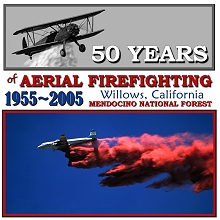



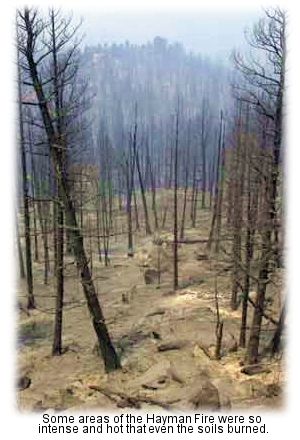 But separate lawsuits could be filed against Barton by four district attorneys from areas damaged by the 138,114-acre Hayman Fire in 2002, according to the
But separate lawsuits could be filed against Barton by four district attorneys from areas damaged by the 138,114-acre Hayman Fire in 2002, according to the 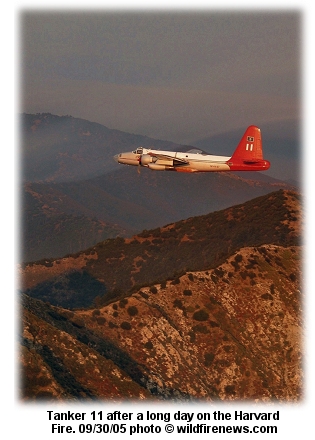 OCTOBER 06 -- LANCASTER, CA:
OCTOBER 06 -- LANCASTER, CA: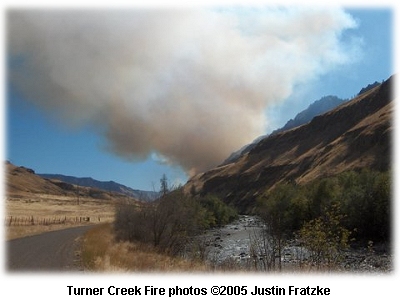
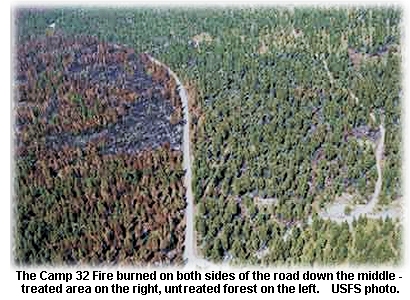 Ron Hvizdak, fire management officer on the Kootenai National Forest, has been using fire to fight fire for decades, but what happened on the Camp 32 Fire this summer dramatically illustrated how thinning and prescribed fire can stop a crowning wildfire.
Ron Hvizdak, fire management officer on the Kootenai National Forest, has been using fire to fight fire for decades, but what happened on the Camp 32 Fire this summer dramatically illustrated how thinning and prescribed fire can stop a crowning wildfire.